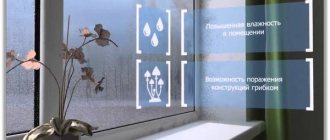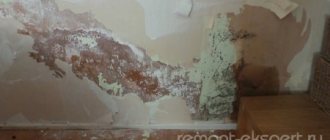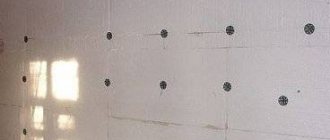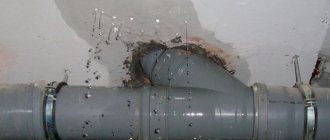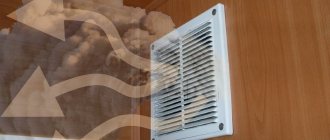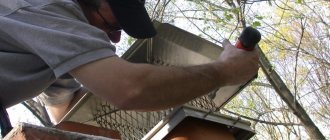Why is the apartment damp, windy and terribly cold? This issue is especially relevant for residents of high-rise buildings. Often they cannot answer it unequivocally, since the apartment climate depends on a number of reasons. Solving such a problem requires an integrated approach. What to do if it’s cold in the apartment? Let's try to answer this question.
Normal temperature in an apartment during the heating season
Permissible temperature values during the onset of cold weather are legalized by GOST R 51617-2000 “Housing and communal services. General technical conditions". Based on this document, the established temperature range is 18 – 25 °C . Based on this, the temperature regime for different types of premises should correspond to the following indicators:
- in the living room - not lower than 18 °C , in the bathroom - not less than 25 °C ;
- in a corner apartment it cannot fall below 2 0°C ;
- in the basement/attic must correspond to 4 °C ;
The upper temperature value in a living room is also established by SanPiN: it should not be higher than 24 °C .
It's cold in the apartment: possible reasons
In winter, the air temperature in a living room very often diverges from established standards. Residents first of all try to find out why it is cold in the apartment. At the same time, they try to independently determine the cause of the heat leak and eliminate the problem on their own. The main factors influencing the establishment of a low room temperature include:
- the presence of cracks in doorways or windows that can allow cold air to pass through;
- insufficient insulation of the balcony area;
- freezing of walls at low air temperatures due to insufficient thickness;
- worn radiators;
- the presence of drafts in the apartment;
- insufficient supply of central heating;
- accidents at the heating station.
Often the reason for a decrease in room temperature can be improper design of heating systems or their installation. The possibility of freezing of the ceiling due to deformation of the roof of the building cannot be ruled out. This entails increased humidity, which further aggravates the situation.
Tips and tricks from experts
There are several simple but quite effective ways to increase the room temperature by several degrees without increasing the heating power of the radiators:
- replace windows with heat-saving double-glazed windows;
- make thermal insulation of walls, basement and roof;
- eliminate unnecessary drafts in the entrance;
- dismantle decorative screens;
- modernize the heating system.
Recently, residents of apartment buildings are increasingly thinking about installing a device such as an individual heat meter. According to the current housing code of the Russian Federation, there are no obstacles to performing such installation work, but from a practical point of view, most of our houses have old pipework that does not allow regulating heat consumption by radiators. Therefore, installing a meter will only allow you to see heating indicators, but not change its value.
It’s cold in the apartment in winter: who should I address complaints to?
Where can I complain if my apartment is cold? This question often interests residents of apartment buildings.
First you need to find out why there is no heat.
Very often, such situations arise due to an accident on heating mains, leading to a shutdown of heating in the entire house, entrance, and even neighborhood. In this case, you need to call the housing and communal services department and find out when the faults will be fixed. If the problem of low temperature exists in a certain apartment/house/entrance and is not a consequence of restoration work at the heating station, then contact the Management Company servicing the house. To review the application, specialists will be sent to inspect the heating system in the apartment in order to identify the cause of the cold. Based on the results of the inspection, a report will be drawn up, which must indicate the time and date of the inspection.
What are the causes of cold walls?
In addition, cold walls can be found both in old houses and new buildings. There can be many reasons for this, including:
- external walls are too thin;
- the side with the cold wall is northern;
- the wall has any defects;
- interpanel seams in a panel house are damaged due to improper application or operational destruction;
- A significant part of the space is adjacent to the outer wall of the end apartments.
A wall that freezes, one way or another, will cause a decrease in the temperature in the apartment, even with an adequate heating system.
The fact is that the heat through the wall will immediately escape to the outside of the house.
In order not to put your own health at risk, not to spoil the interior of the apartment, and also not to pay for “heating” the street, it is necessary to immediately repair the walls and insulate them. There are several ways to solve the problem of cold walls in an apartment:
- insulation with expanded polystyrene or mineral wool;
- installation of a heated floor on the wall;
- additional placement of heating devices;
- installation of a warm wall system;
You can insulate the wall both outside and inside the room. It depends on the individual characteristics of the apartment and your preferences.
How to file a complaint about lack of heating
There is no legally established sample application/complaint regarding lack of heating. Typically, such a document is drawn up in any form.
Most companies have developed special templates that make the applicant’s task much easier.
As a rule, such documents contain the following items: header, content of the complaint, date/signature of the applicant.
On the right side of the sheet (slightly to the right of the middle) the full name of the organization to which the complaint is sent, the initials of the official, then information about the applicant (full name, residential address, contacts), below in the middle - the type of document (complaint/ statement/claim).
The main part of the document - the contents of the complaint - includes the following information:
- grounds for claim/complaint;
- link to a document regulating temperature standards;
- an indication of their non-fulfillment (attached act);
- a statement of the possible consequences of failure to comply with these requirements (recalculation, compensation for damage, etc.);
- suggestions to resolve the problem;
- requirement to restart the heating supply.
At the bottom of the sheet, the document is signed by the applicant with the obligatory indication of the date of application. You can add an annex to the application - documents (acts) proving the fact of lack of heat supply.
| To the director (indicated by type: manager, housing and communal services, housing cooperative) Petrov P.P., located at the address: (specified) Sidorov S.S., residing at (address and contacts are indicated) |
| statement/complaint/claim. According to the agreement (number, date) concluded between (institution is called) and me, the owner of the residential premises (address is indicated), the company provides utilities, including the supply of heat in cold weather. The requirements for their provision are legitimized by Decree of the Government of the Russian Federation dated May 6, 2011 No. 354, which outlines the permissible temperature levels in residential premises. In the apartment I own, the standards established by law are not observed (specific temperature indicators are indicated on different days, in different rooms). This is evidenced by a temperature check report drawn up in the presence of employees of the Management Company (see Appendix). I ask you to eliminate the above-mentioned interruptions in the heat supply in my apartment within (time indicated) and recalculate the cost of utilities. In case of failure to comply with these comments, I will be forced to contact higher organizations with a demand for compensation for material and moral damage. date Signature |
The radiators are hot, but the house is still cold: what to do
Heating radiators are not always the cause of cold in an apartment. They can be fiery and the room temperature is low. What to do if it’s cold in your apartment not because the batteries are turned off.
First of all, it is important to establish the cause of such a situation and begin to eliminate it.
The first thing you should pay attention to is the quality of the window frames.
Old wooden frames have long outlived their usefulness and require replacement. An excellent solution would be to install modern plastic double-glazed windows. If they are already installed, then you need to call a technician to check and possibly identify the cause of cold air leakage. You can insulate old windows using cotton wool, tape or foam rubber. More reliable materials include silicone sealant, putty and rubber gaskets.
It is worth paying attention to the walls: due to violations of technology during the construction of the house, they may freeze or crack. In this case, they require internal and external insulation with special materials: mineral wool, polystyrene foam boards, cellulose, foil and liquid insulation, polyurethane foam, penoplex. Insulation of the outer part of the wall should only be carried out by specialists. In this case, it is recommended to sheathe the facade of the balcony, which very often causes the penetration of cold air.
If the source of cold is the floor, it is necessary to improve it. Today, the heated system is especially popular.
In addition, it is worth checking the tightness of the front door: you can replace the trim and eliminate cracks and holes that allow cold air to pass through.
Reasons why the floor may be cold and solutions
Are cold floors the first and most unpleasant impression of your day? Everything can be corrected. It is only important to correctly “diagnose” the problem, because the matter is not always just the lack of a “warm floor” system or the unfortunate location of the room - everything is much more interesting. Now we will look at the main causes of cold floors and ways to correct this problem.
Reason #1. Crevices
The first and most common culprit for cold floors is cracks. So what should you do if the floors in your dacha are exactly like this? Try this interesting option, especially popular back in Soviet times. Cheap and cheerful, as they say:
–Step 1. Seal the gaps between the boards with putty. Yes, you can use the most ordinary store-bought paint, paint it with regular floor paint and leave it like that - but it won’t work. The fact is that a person puts pressure on the floorboards with his weight, and they eventually bend - which is why both the putty and the paint fly off quite quickly. That’s why we make putty in our own way: mix finely sifted sawdust with PVA glue (for furniture). Fill the cracks with this compound, having previously lubricated the edges of the floor slats with the same PVA. Stolyar glue is also suitable due to its water resistance.
–Step 2: Now, use an ax blade to cut away the exposed old paint chips on the floorboards and lightly sand the entire floor with medium-grit sandpaper.
–Step 3. In individual problem areas, secure the boards with self-tapping screws. Just “sink” the caps themselves and fill the holes with the same mixture as the cracks.
–Step 4: Thoroughly vacuum the entire surface.
–Step 5. Now purchase thin paper wallpaper with a wood texture (any other option is possible, of course).
–Step 6. Roll out the rolls in a convenient place and cover with a thin layer of parquet varnish (dilute it a little with solvent). This is necessary so that the wallpaper becomes more durable when wetted with PVA glue, also thinly diluted with water. In addition, otherwise the texture of the wallpaper may also be erased during smoothing. And stains will appear from accidental touches. By the way, we varnish the textured surface.
–Step 7. Now we cut individual sheets of wallpaper - the same width as each individual board.
–Step 8. Apply glue to the boards and place the prepared sheets. If the gap is still noticeable, then lightly press the paper into it. But each stripe must overlap the next. By the way, if the varnish between the strips bursts, this will only add decorativeness to the entire coating, imitating a real plank floor.
–Step 9. Press the paper strips tightly and smooth them with a clothes brush to remove air bubbles.
–Step 10. Use a clean rag to remove excess glue.
–Step 11. Let the new floor dry for at least three days. After this, we cover it with parquet varnish in three layers.
This is what it looks like:
Here's what to do when the gaps are too large:
This floor will serve you for a surprisingly long time, but you will forget about drafts through the cracks forever.
But if things are really bad, do this:
And in the absence of funds, like this:
Reason #2. Dampness under the floor
Dampness in the underground can also cause a lot of worries. So, already in the spring, damp and warm air enters the house through the vents, and the basement at this time is still cold. Usually this flow finds its condensation point on the joists, and manages to not only fill the unprotected insulation with moisture, but even hang icicles on it. And this cold dampness directly touches the floor.
What to do in this case? First of all, protect the insulation from below - at least with the same polyethylene board. Secondly, if this happens all the time, stop using vents altogether and organize underground ventilation through a grille in the house itself.
You also need to try to at least somehow insulate the foundation itself with the base so that it does not freeze so much in the winter:
By the way, you will be surprised, but your tailed tenants - mice - also manage to make their moves so that you feel a considerable draft near the walls. Control methods: cat, electric cat or ultrasonic repeller.
Reason #3. Lack of insulation
When you do everything in the house with your own hands, would it even occur to you to put half as much insulation under the floor as the instructions indicate? It’s unlikely, you’ll agree. After all, you’ll be freezing later. But it’s easy for a hired construction team. The pie floor looks decent, everything was done, at first glance, professionally, and the lack of building materials is not so easy to calculate. Especially if you yourself don’t understand much about it. But the same balance can be given to the second client, and everything will also look decent. But they paid the foreman for two whole sets!
Result: cold floor. What to do? It’s easy to check the insulation layer: find on the Internet what layer the material you have should have, and check it with a simple metal ruler. An obvious drawback? The floor will have to be completely opened up.
So, it is also possible to completely solve the problem thanks to expanded clay insulation - this is a light and harmless material that serves as an excellent heat and vapor barrier. Or more complex, but no less effective options for complex cases - we have provided step-by-step instructions below.
When it comes to an apartment, there are many options. But here is the simplest and most cost-effective option to make the floors in a private home much warmer:
–Step 1. At the lowest point of the underground - a clay castle, 10-20 cm.
–Step 2. Place 10 cm of polystyrene foam on top of it, very tightly. This insulation should completely cut off the cold from the ground.
–Step 3. On the foam plastic – a layer of fine expanded clay, up to 70 cm.
-Step 4. Now - an air gap with vents in the foundation. We close them completely for the winter.
–Step 5. Next, we install the wooden floors. Such a floor should lie on the grooves of the log, which are closed with a rubber band (if you have just such walls). The purpose of the tape is to separate the floors from the wall so that the sound of walking on the floors is not transmitted to the walls. Those. basic sound insulation.
–Step 6. Next we lay out sheets of rubber on which the waterproofing is laid.
–Step 7. And finally, if desired, a layer of screed 7 cm thick with warm floors. After that - the floor covering.
If you just have a wooden floor with joists, and underneath there is just damp earth, do this:
–Step 1. Carefully remove the covering.
–Step 2. We treat the logs with a special compound (you can even just use used oil).
–Step 3. Attach a corner to the joists for tensioning the cord. We pull the cord - the foam will be held on it, and the corner can be removed. Attach the cord to the joists.
–Step 4. Lay down 50mm foam sheets. We seal the gaps between it and the tree with foam.
–Step 5. Lay Penofol on top of the foam, thickness 3 mm. We install the floor boards in their place.
–Step 6. Now we fix the foam from the underground. So, we take nylon roofs from cans, and press the foam using self-tapping screws and a screwdriver.
This is the simplest and most unpretentious way. You can also install heated floors:
Reason #4. Cold foundation
Large heat losses for the floor can also be incurred by the foundation with a plinth. What to do with this, watch the video:
And you can read more about insulating the floor and foundation on the pages of our website - detailed step-by-step photo instructions have been compiled especially for you.
Reason #5. Laminate
Although laminate seems warmer than tiles, children will not play on it either - it’s unpleasant. Why is that? It's all about the finishing layer - it's a decorative film, not a cut of natural wood. And it has greater thermal conductivity. In a word, cold laminate is a common problem. And it is usually solved in two ways: by placing a technical cork under the coating, which has the property of retaining heat well, or by placing an infrared film floor.
The fastest and most reliable option, of course, is to install a heated floor system. At least, in the absence of cracks and dampness, the floor will not seem cold. Just keep in mind: the “warm floor” system does not mean that your coating will actually heat (with the exception of ceramic tiles), the discomfort will simply disappear, and nothing more.
A heated floor system is good not only because it is pleasant to walk on such a floor barefoot and moisture evaporates easily, but also because some heat will remain even when the electricity is turned off.
What else can you do? If possible, if you installed this flooring using the interlocking method, lift it up and install the underfloor heating system. If it's adhesive, then don't touch it. Instead, pay attention to the heating system: arrange it lower than it is, attach IR heaters to the walls - they warm objects, not air, according to the manufacturer.
Reason #6. Absorption of infrared rays
Also pay attention to such a physical phenomenon as infrared radiation. It happens that floors absorb heat so much that, without knowing it, you heat the underground. Laminate is a good conductor. Therefore, if everything is insulated and there are no gaps in the covering, place a layer of foil material under it, only with the front side up. You will immediately notice the difference, believe me!
Reason #7. Tactile sensations
And finally, one of the most unexpected reasons why the floor can be cold is purely tactile sensations. Simple physics is at work here: cold as a physical phenomenon does not actually exist - it is simply a lack of heat. And different materials do not have the same ability to absorb this heat from other sources. And the absorption occurs for the sake of updating the same balance. And those objects and coatings seem warmer, which take heat away from you more slowly.
So, for example, if you get up from your favorite place, you can feel with just your palm how your body has heated one part of the sofa or bench, while the other remains cold. Moreover, the heated place will be approximately the same temperature as your skin. The same applies to floors - as soon as your foot touches them, a rapid heat exchange occurs. And its intensity depends on the thermal conductivity of the flooring material: the higher it is, the colder the floor will seem, unless, however, you heat it from below.
It turns out that the approximate room temperature is about 18-20°C, and below is about 15-17°C. This is exactly the temperature the floor will have. And now you see what’s the matter: 36.6° - 17°? This is why we can experience quite unpleasant sensations from walking barefoot, even though it doesn’t seem to be cold in the house itself. And this can really make you sick - after all, heat is “downloaded” from us, and the body needs it.
So what to do? And is it then necessary to install “warm floors”? Not at all. If you definitely don’t have any cracks, and the floors aren’t freezing due to an improperly constructed underground, and it’s definitely not a matter of organizing the heating, then work with the floor covering itself. Thus, ceramic tiles have the highest thermal conductivity - they “rob” us of heat the fastest, especially in the bathroom area. And don’t walk around endlessly in rubber slippers, and the rugs in such a room can become damp. Not to mention the fact that no one will tear off the tiles again - there is no other way to put a heated floor system under it.
Here, look how they solve this problem overseas with humor and creativity:
Modern PVC tiles would also be a good option: they have the same low thermal conductivity as cork. You can even take it onto the balcony for the sake of experiment, leaving it there all winter night. By morning, pick it up - it won’t seem cold even then.
Don't endure the cold - the time and effort spent are worth it to greet every morning in comfort!
Share:
What else can you do in the fight for warmth?
You can fight the cold in more economical ways. You can keep your apartment warm by observing the following conditions:
- When cold weather sets in, hang thick curtains. If you close them after dark and open them early in the morning, they will act as a heat insulator and block access to cold air flows.
- Partially cover the ventilation holes with thick paper.
- Buy electrical appliances: heater, blanket, cape, heating pad. Modern heating devices are ergonomic, safe and do not consume a lot of electricity.
- Open bathroom doors after bathing.
- Attach foil material between the wall and the radiator, which will reflect heat and direct it into the room.
- Leave the oven door open after cooking.
The warmth of your loved one can truly, with all your heart, warm you during the cold season. Hug more often, warm each other, and then you won’t be afraid of any cold.
